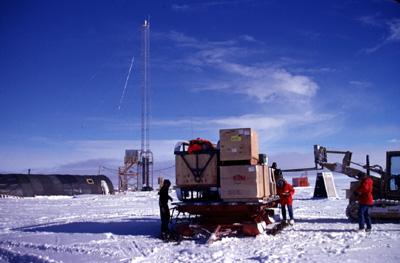
Right: Glaciologist digging a snow
pit on the Antarctic ice sheet
Snow and ice are pervasive elements of high latitude
environmental systems and have an active role in the global environment.
The glaciology program is concerned with the study of the history and
dynamics of all naturally occurring forms of snow and ice, including
floating ice, seasonal snow, glaciers, and continental and marine ice
sheets. Program emphases include paleoenvironments from ice cores, ice
dynamics, numerical modeling, glacial geology, and remote sensing of
ice sheets. Some specific objectives include the correlation of climatic
fluctuations evident in Antarctic ice cores with data from arctic and
lower-latitude ice cores, the integration of the ice record with the
terrestrial and marine records, the investigation of the physics of
fast glacier flow with emphasis on processes at glacier beds, the investigation
of ice-shelf stability and the identification and quantification of
the feedback between ice dynamics and climate change. These topics come
together in the multidisciplinary West
Antarctic Ice Sheet program .

Left: Glaciologist traveling an ice
stream in west Antarctica
West
Antarctic Ice Sheet program (WAIS), a major initiative of
the Office of Polar Programs, focused in the Antarctic Glaciology Program
and Antarctic
Geology and Geophysics Program .The WAIS program is designed
to advance a better understanding of the West Antarctic ice sheet. Scientists
involved in the WAIS program want to know what triggers marine ice sheet
collapse and evaluate the possibility that this could happen in West
Antarctica. Predicting the ice sheet's future behavior requires an understanding
of its history, current state, internal dynamics and coupling to the
current global climate.
Ice cores from Antarctica are important in order
to determine whether the rapid climate changes recorded in Northern
Hemisphere ice cores, such as those obtained from Summit, Greenland
in the Greenland
Ice Sheet Project II (GISP2), occurred globally. The only
area where an ice core capable of providing a long, annual resolution
history of Southern Hemisphere climate exists is in the interior of
West Antarctica, where compressed snow layers are thick enough to allow
absolute dating. The objective of the WAISCORES-
Siple Dome ice coring program is to obtain such a core.
The ice cores to be drilled as part of the WAISCORES
program will also complement those already under study from Taylor
Dome and Vostok
Station in East Antarctica. Ice cores are unique in that
they continuously record and preserve annual precipitation, atmospheric
temperature and components of the atmosphere, including gases, soluble
and insoluble

Above: Siple Dome ice core drilling site
aerosol particles from a variety of sources (biogenic, terrestrial,
solar, marine, volcanic, anthropogenic). Recent work on the Vostok ice
core has lead to important advances in understanding past climate and
environmental changes over glacial-interglacial cycles. Future work
in this area should focus on developing a long interhemispheric record
of paleoclimate which can be correlated with the deep sea core record.
These cores will provide samples for future research
for many years to come. Cores are currently in storage at the National
Ice Core Laboratory . NICL is a government-owned facility
for storing, curating, and studying ice cores recovered from the ice-covered
regions of the world. NICL is supported through an Interagency Cooperative
Agreement with the United
States Geological Survey. NICL provides NSF- and USGS-funded
principal investigators and their collaborators with the capability
to conduct examinations and measurements of ice cores while preserving
the integrity of these cores in a safeguarded environment.

Right: The Ross Ice Shelf, also known
as "The barrier" by early explorers
In addition to the West Antarctic Ice Sheet Program,
the Antarctic Glaciology Program has a number of other areas of focus.
One of the main areas of interest relates to the determination of the
Cenozoic history of the Antarctic ice sheet, including the uplift of
the Transantarctic
Mountains and its interaction with global climate (e.g. response
to the Pliocene warming). Much of the glacial geological research in
the Transantarctic Mountains relate to understanding the history of
the ice sheet during the Pliocene, as well as more recent fluctuations
during the Quaternary.

Left: Shallow ice core drilling at
Dome C, East Antarctica.
The Space Science and Engineering
Center (SSEC) at University of Wisconsin, Madison is supported
by the Office of Polar Programs to meet the drilling requirements of
all programs in OPP. SSEC focuses on ice drill
development for NSF-supported remote field projects. Investigators who
plan to request technical support from SSEC should
include with their proposal a cost estimate (budget and justification)
for the equipment or drilling support that might be provided by SSEC
if the project is funded. This information is in addition to the regular
budgets included with the proposal. Investigators should contact SSEC
if they have questions or need further information for a correct cost
estimate. The Research Support Manager in
the Polar Research Support Section, as well as the program manager
to whom you are submitting your proposal, should be notified when an
investigator is requesting SSEC support.

Left: Diagram of West
Antarctic Ice Sheet
An ice sheet covers all but 2.4 per cent of Antarctica's
14 million square kilometers. At its thickest point the ice sheet is
4,776 meters deep. It averages 2,160 meters thick, making Antarctica
the highest continent. This ice is 90 percent of all the world's ice,
and it is 70 percent of all the world's fresh water. The West Antarctic
Ice Sheet contains more than 3.2 million cubic kilometers of
ice, is the last ice sheet on Earth resting in a deep marine basin and
is the most likely player in any future, rapid sea level rise. Marine-based
ice sheets are inherently unstable and vulnerable to rapid collapse.
This is known from glacial geologic studies of land and marine based
deposits in the northern hemisphere, where most of these marine ice
sheets once existed. Complete collapse of the West Antarctic ice sheet
would rapidly raise global sea level by about 6 m.